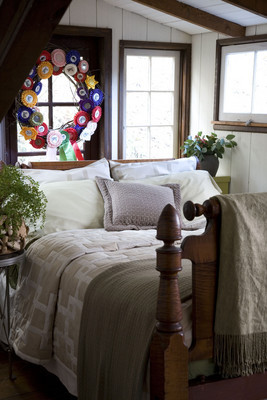Earth-friendly furnishings make sense
It's easier than ever to make your visitors green with envy when they visit your green furnished home. Many professional interior designers have been finding ways to make your home a little more eco-friendly.
Trampas Johnston, interior design program chair at International Academy of Design & Technology Las Vegas, encourages the use of organic, sustainable and recycled products in interior design.
"It's all about reducing your carbon footprint," he said. "Fortunately, manufacturers are creating products that exceed the standards of the past without compromising diversity."
Popular eco-friendly interior products include bamboo, cork, sustainable harvest teak, cotton, hemp, post-recycled carpet, terrazzo and Vetrazzo -- just to name a few.
According to Johnston, being environmentally sensitive also includes preservation.
"By refinishing, repurposing or recycling furnishings and other home accessories, we create unique, custom pieces that would otherwise end up in the landfill," he said. "Being environmentally aware is simple common sense. For example, replacing a perfectly good wood floor with bamboo flooring may seem, at first blush, to be the green thing to do. Yet, if the existing floor is in good condition, it's hard to justify getting rid of it just for the sake of change."
Over the last few years, people have begun to feel guilty about purchasing new furnishings, said Dana Pfeiffer, who co-owns the design company Pholishus based in Springfield, Ill. That's why she and her business partner, Tamara Holland, have recently begun designing green furniture.
"We have a great cocktail table made out of recycled newspaper and kirei (leftovers from corn fields) and a bar that is made out of bamboo and PaperStone," said Pfeiffer.
Made out of 100 percent post-consumer recycled paper, this new material has been going into everything from cutting boards to countertops. "The PaperStone, if scratched, can be sanded out with low-grit sandpaper and the color is through and through," she said. "Green table tops are ideal because they create a natural barrier against bacteria settling into the surface."
Lee Lundquist, interior designer at Robb & Stucky Interiors at Town Square Las Vegas, also suggests looking for recycled, reclaimed or renewed home furnishings. Robb & Stucky offers an hourglass spot table made of reclaimed pine and a Kampung round end table made of reclaimed teak.
The company provides customers with green alternative interior design tips that make use of natural resources. Lundquist also suggests the use of low VOC (volatile organic compounds) in all paints and finishes as well as organic and renewable fibers such as linen, cotton and wool.
"Making little changes really makes a difference when designing green," said Lundquist.
Of course, there's more to decorating a home -- and living green -- than just buying furniture. It's important to pay attention to other details. That's why well-known eco-stylist Danny Seo has devoted two-thirds of his young life (he's just 32) to saving the environment.
In his book, "Conscious Style Home" (St. Martin's Press), he writes about using recycled paint to brighten rooms, bamboo blinds to let the sunshine in and recycled glass tiles in bathrooms. He also promotes restoring and reusing existing furniture.
Seo has partnered with two companies to help more people go green. He has collaborated with Simmons to develop a Natural Care by Danny Seo line of mattress products.
Seo has also been working with JCPenney as its Green Living Partner, advising on the company's Simply Green products. He currently has a line of eco-friendly bedding, towels and home accessories that are available nationwide and on its Web site, www.jcpenney.com.
Creators News Service contributed to this article.

















